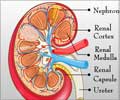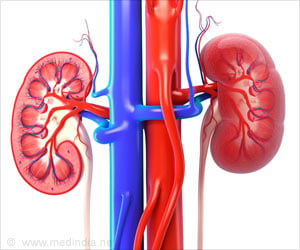A novel nanotechnology approach has been used to create nanostructures that can help prevent and treat acute kidney injury (AKI), which is a serious medical disorder that exhibits high mortality rates.
- Novel nanostructures called DNA origami nanostructures (DONs) have been developed using the latest nanotechnology techniques
- Imaging studies using positron emission tomography (PET) have shown that when these DONs are injected, they preferentially accumulate in the kidneys
- Acute kidney injury (AKI) can be caused by oxidative stress. The DONs, accumulated in the kidneys, can counteract the oxidative stress, thereby preventing the onset of AKI in healthy kidneys or treating AKI in diseased kidneys
A novel method for treating and preventing acute kidney injury (AKI) was developed using self-assembling nanomaterials. These nanomaterials are suitable for use in living systems due to their stability, low toxicity, and low immunogenicity. However, this has so far not been possible, but this new study has made major headway in this direction and the study was published in Nature Biomedical Engineering, a Springer Nature publication. Acute kidney injury (AKI), formerly known as acute renal failure is a serious condition in which the kidneys shut-down abruptly, leading to a rapid build-up of nitrogenous waste and reduced urine production. This can occur within hours or days of onset of disease, which often leads to various complications. In advanced stages of AKI, kidney transplantation may be required as well as supportive treatment measures such as rehydration and hemodialysis.
Approximately 13.3 million new AKI cases are reported annually, with 1.7 million deaths. Therefore, protecting healthy kidneys from injury and treating those already injured is a major medical challenge. Currently, there is no cure for AKI.
Read More..
Defining Nanotechnology and Nanomedicine
- Nanotechnology: This is the branch of technology that deals with dimensions and tolerances of less than 100 nanometers (nm), especially the manipulation of individual atoms and molecules.
- Nanomedicine: This involves the engineering of atoms and molecules at the nano-level for developing medical applications. This is a new and exciting area of biomedical research and has opened hitherto unexplored areas such as advanced imaging and therapeutic strategies against various diseases, including AKI.
The study was led by Dr. Hao Yan, Milton D. Glick Distinguished Professor and Director, Center for Molecular Design and Biomimetics, Arizona State University, USA. Dr. Yan’s collaborator was Dr. Weibo Cai, Vilas Distinguished Achievement Professor, University of Wisconsin-Madison, USA.
“The interdisciplinary collaboration between nanomedicine and the in-vivo imaging team led by Professor Weibo Cai at the University of Wisconsin-Madison and the DNA nanotechnology team has led to a novel application – applying DNA origami nanostructures to treat acute kidney injury,” says Professor Yan. “This represents a new horizon for DNA nanotechnology research.”
Study Procedure
The study was carried out in mice and in cell culture, using human embryonic kidney (HEK) cells. Kidney function in mice was assessed by measuring the levels of serum creatinine and blood urea nitrogen (BUN). The safety of the DONs was established by evaluating their potential to elicit an immune response in mice by measuring the levels of interleukin-6 (IL-6) and tumor necrosis factor-α (TNF-α). These immunogenicity studies revealed that the DONs were not immunogenic. Moreover, histologic staining of vital organs such as the heart, liver, lungs, spleen, and kidneys indicated that they had very low toxicity. These features make DONs attractive therapeutic agents for clinical studies in humans.Study Findings
Professor Yan and his team engineered all three types of DONs (tubular, triangular, and rectangular shaped). These were radio-labeled for studying their behavior in mice kidneys by using positron emission tomography (PET) imaging. The PET scans revealed that the DONs accumulated in the kidneys of both healthy mice, as well as those suffering from AKI. Furthermore, of the three shapes of DONs used in the study, the rectangular shaped DONs exhibited a superior therapeutic potential than the others. Their efficacy was comparable to the antioxidant drug, N-acetylcysteine (NAC), which is currently regarded as the “Gold Standard” for the treatment of AKI.Mechanism of Action of DONs
It is well established that oxidative stress, mediated by reactive oxygen species (ROS), is a major factor in the pathogenesis of AKI. In the present study, the observed protective and therapeutic benefits of DONs were due to their ability to scavenge these ROS. This protects susceptible kidney cells from oxidative damage. These studies, carried out in HEK cells subjected to ROS, showed that the DONs could counteract the oxidative stress within two hours of incubation with these affected human kidney cells.What is the Importance of the Study?
This is the first study to use DONs within living systems, using quantitative imaging to track their behavior. PET imaging allowed for real-time monitoring of the circulation of these DONs within the living organism and for assessing their physiological distribution. PET revealed that the accumulation of the rectangular shaped DONs in the kidneys was comparatively much higher than the other DONs, and therefore proved to be most effective for treating AKI in mice. This opens new avenues for the development of novel therapeutic strategies for the treatment of AKI as well as other kidney diseases.In this regard, Professor Cai said: “This is an excellent example of team science, with multidisciplinary and multinational collaboration.The four research groups are located in different countries, but they communicate regularly and have synergistic expertise. The three equally-contributing first authors (Dawei Jiang, Zhilei Ge, Hyung-Jun Im) also have very different backgrounds, one in radiolabeling and imaging, one in DNA nanostructures, and the other in clinical nuclear medicine. Together, they drove the project forward.”
Conclusion
The study establishes the ability of DONs to confer localized protection to kidneys from AKI, based on their effective ROS scavenging ability in both HEK cell culture and in living mouse kidneys. It is, therefore, plausible that these therapeutic benefits could be extended to kidneys already damaged by AKI or other kidney diseases.The study opens up new possibilities for the development of novel therapeutic strategies using programmable nanostructures that can be engineered for a variety of applications, including targeted drug delivery and tissue repair, amongst others.
Reference:
- DNA origami nanostructures can exhibit preferential renal uptake and alleviate acute kidney injury - (http://dx.doi.org/10.1038/s41551-018-0317-8)
Source-Medindia















